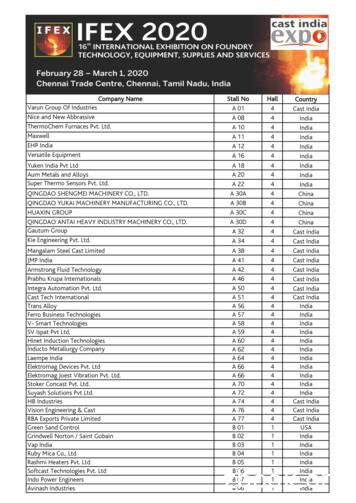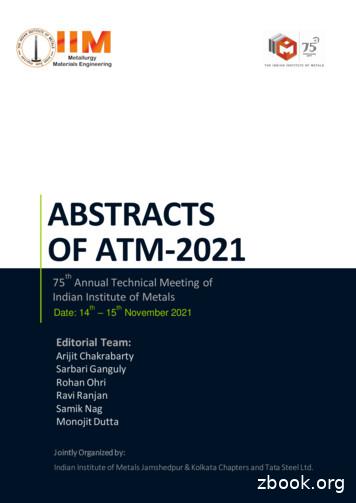Types Of Evidence - Dr. Hall's Science Site
Types of Evidence
Types of EvidenceObjectivesStudents will understand:The value of indirect and direct evidence in acourt of law.That eyewitness accounts have limitations.What physical evidence can and cannot prove incourt.That the forensic scientist’s main goal is to finda unique source for the evidence.Students will be able to:Explain the difference between indirect anddirect evidence.Describe what is meant by physical evidenceand give examples.Distinguish individual evidence from classevidence.Determine the significance of class evidence.2
Types of EvidenceClassification of Evidence*Evidence is something that tends to establish or disprove a fact*Two types:Testimonial evidence is a statement made under oath;also known as direct evidence or prima facie evidence.Physical evidence is any object or material that is relevant in acrime; also known as indirect evidence. Examples are documents,soil, drugs, toolmarks, impressions, glass.Trace evidence refers to physical evidence that is found insmall but measurable amounts, such as strands of hair, fibers,or skin cells.3
Types of EvidenceReliability of EyewitnessFactors that affect accuracy:Nature of the offense and the situation inwhich the crime is observedCharacteristics of the witnessManner in which the information is retrieved*Crime scene too dark*Encounter too brief*Presence of weapon*Time between crime and questioning*New Information*Stress and fear4
Types of EvidenceReliability of Eyewitness Continued:Additional factors:Witness’s prior relationship with the accusedLength of time between the offense and the identificationAny prior identification or failure to identify the defendantAny prior identification of a person other than the defendant by theeyewitness5
Types of EvidenceEyewitness- A police composite may bedeveloped from the witnesstestimony by a computer program orforensic artist.- “Perception is reality”- As a result of the influences ineyewitness memory, physicalevidence becomes critical.FACES—a compositeprogram by InterQuest6
Types of EvidenceValue of Physical EvidenceAs a result of the influences oneyewitness memory, physical evidencebecomes critical.Any material or objectIs generally more reliable than testimonial evidenceCan prove that a crime has been committedCan corroborate or refute testimonyCan link a suspect with a victim or with a crime sceneCan establish the identity of persons associated with a crimeCan allow reconstruction of events of a crime7
Types of EvidencePhysical Evidence continued: Two main classes of Evidence that showvalue: Indirect and circumstantialValue of Physical Evidence:- Prove crime was committed and set crime- Back up or prove false witness testimony- Link suspect to victim and/or crime scene- Determine identity of people involved w/crime- Reconstruct a crime8
Types of EvidenceReconstructionPhysical evidence can be used toanswer questions about:What took place at a crime sceneThe number of people involvedThe sequence of eventsHow the victim was killedA forensic scientist compares the questioned or unknown sample fromthe crime scene with a sample of known origin.9
Types of EvidenceTypes of Physical EvidenceTransient evidence is temporary; easily changed or lost; usually observed bythe first officer at the scene.Pattern evidence is produced by direct contact between a person and an objector between two objects.Conditional evidence is produced by a specific event or action; important incrime scene reconstruction and in determining the set of circumstances orsequence within a particular event.Transfer evidence is produced by contact between person(s) and object(s), orbetween person(s) and person(s).Associative evidence is something that may associate a victim or suspect witha scene or with each other; e.g., personal belongings.—Henry C. Lee and Jerry Labriola, Famous Crimes Revisited, 200110
Types of EvidenceExamples of Transient EvidenceOdor—putrefaction, perfume, gasoline,urine, burning, explosives, cigarette orcigar smokeTemperature—surroundings, car hood,coffee, water in a bathtub, cadaverImprints and indentations— footprints,teeth marks in perishable foods, tiremarks on certain surfaces11
Types of EvidenceExamples of Pattern EvidencePattern evidence—mostly in the form of imprints, indentations,striations, markings, fractures, or depositsBlood spatterClothing or article distributionGlass fractureGunpowder residueFire burn patternMaterial damageFurniture positionBody positionProjectile trajectoryToolmarksTire marks or skid marksModus operandi12
Types of EvidenceExamples of Conditional EvidenceLight—headlight, lighting conditions,lights on or offSmoke—color, direction of travel,density, odorFire—color and direction of the flames,speed of spread, temperature andcondition of fireLocation—of injuries or wounds, ofbloodstains, of the victim’s vehicle, ofweapons or cartridge cases, ofbroken glassVehicles—doors locked or unlocked,windows opened or closed, radio offor on, odometer mileageBody—position and types of wounds;rigor, livor, and algor mortisScene—condition of furniture, doorsand windows, any disturbance orsigns of a struggle13
Types of EvidenceClassification of Evidence by NatureBiological—blood, semen, saliva, sweat, tears, hair, bone, tissues, urine, feces,animal material, insects, bacteria, fungi, botanical materialChemical—fibers, glass, soil, gunpowder, metals, minerals, narcotics, drugs,paper, ink, cosmetics, paint, plastic, lubricants, fertilizerPhysical—fingerprints, footprints, shoeprints, handwriting, firearms, tire marks,toolmarks, typewritingMiscellaneous—laundry marks, voice analysis, polygraph, photography, stressevaluation, psycholinguistic analysis, vehicle identification14
Types of EvidenceEvidence Characteristics:INDIVIDUAL VS CLASSIndividual—can be identified with a particular person or a single sourceFingerprintsBlood DNA TypingClass—common to a group of similar objects or persons15
Types of EvidenceProduct Rule The goal is to narrow down class evidence toindividual evidence as much as possible. The product rule states that multiplyingtogether the frequency of each evidential factorwill determine how common that combinationof factors is in the general population.16
Types of EvidenceProduct Rule continued: For example, in the OJ Simpson murder case,a bloodstain located at the crime scene wasfound to contain a number of factors thatcompared to OJ’s blood: Blood Factors AEsDPGM 2 2-Frequency26%85%2%17
Types of EvidenceProduct Rule continued: The product of all the frequencies determinethe probability that any one individualpossesses such a combination of blood factors: 0.26 x 0.85 x 0.02 0.0044, .44% Or Less than 1 in 200 people would be expectedto have a particular combination of bloodfactors.18
Types of EvidenceProduct rule The bloodstain factors did not match either ofthe two victims, thus eliminating them aspossible sources of the blood. The bloodstains were not individualized to OJSimpson either.19
Types of EvidenceClass vs. Individual EvidenceThese fibers are class evidence;there is no way to determine ifthey came from this garment.The large piece of glass fits exactlyto the bottle; it is individualevidence.20
Types of Evidence1. Several pieces of torn T-shirtwere found close to ahomicide victim. A torn Tshirt was found in thesuspect’s bedroom. Can thetorn T-shirt and the piecesbe individualized. Explain.Individual or Class?2. Can very small glassfragments be individualized,or uniquely associated witha broken bottle? Explain2121
Types of EvidenceIndividual or Class? (continued)3. At the scene of a robbery apartial note was found on a 4. Can the handwriting beindividualized to the sametorn piece of paper. Aperson from both sources ofsimilar piece of torn paper,the torn paper? Canthat seemed to completefingerprints on the note(s) bethe original sheet of paperindividualized to the person?and note, was found at thesuspect’s office. Can theseExplain.torn pieces of paper beindividualized to eachother? Explain.2222
Types of EvidenceEvidence: Individual or Class? (continued)5. Several tabs from soda canswere found in a suspect’skitchen. A soda can wasfound at the scene of thecrime that could beuniquely associated withone of the tabs. How is thispossible?6. A suspect was found witha book of matches (somewere missing) in hispocket. At the scene of aknown arson matcheswere found. Are thematches from the scene,individual or classevidence? Explain.2323
Types of EvidenceEvidence: Individual or Class? (continued)7. A gun was found in asuspect’s car, these bulletswere retrieved from themurder scene. Can thesebullets be individualizedto the gun? Explain.8. A piece of duct tape wasused to close a victim’smouth during a kidnapping. A roll of the samebrand of duct tape wasfound in the suspect’sgarage. Would this beconsidered class orindividual evidence?Explain.2424
Types of EvidenceEvidence: Individual or Class? (continued)9. The sports section of the10. At a homicide scene onenewspaper was found at alatex glove was found. Arobbery scene. The financebox of latex gloves weresection was found at thefound in a suspect’ssuspect’s office. Was thekitchen. Can the gloves befinance section individualindivid-ualized to the box?or class evidence? Explain.Explain.2525
Types of EvidenceForensic InvestigationsInclude some or all of these seven major activities:1. Recognition—the ability to distinguish important evidencefrom unrelated materialPattern recognitionPhysical property observationInformation analysisField testing2.Preservation through the collection and proper packaging ofevidence26
Types of EvidenceForensic Investigations, continued3.Identification using scientific testingPhysical propertiesChemical propertiesMorphological (structural) propertiesBiological propertiesImmunological properties4.Comparison of class characteristics measured against those ofknown standards or controls; if all measurements are equal, thenthe two samples may be considered to have come from the samesource or origin27
Types of EvidenceForensic Investigations, continued5.Individualization in demonstrating that the sample is unique, evenamong members of the same class6.Interpretation—giving meaning to all the information7.Reconstruction of the events in the caseInductive and deductive logicStatistical dataPattern analysisResults of laboratory analysis—Henry C. Lee and Jerry Labriola, Famous Crimes Revisited, 200128
Types of EvidenceNational Databases IAFIS – Integrated Fingerprint Identification System CODIS – Combined DNA Index System NIBIN – National Integrated Ballistics InformationNetwork IBIS - Integrated Ballistic Identification System PDQ – International Forensic Automotive Paint Data Query29
Types of EvidenceCLASS ASSIGNMENTOJ Simpson Case: Examples of Mistakes with EvidenceYou may work in groups up to 3 people, one paper per group.Focus on the types of evidence collected and errors that were thelegal responsibilities of the crime scene investigators/detectives.This may include items in categories such as:Bill of Rights Amendment ViolationsChain of Custody ErrorsCrime Scene ErrorsBe prepared to discuss your findings with the class.30
Types of Evidence 3 Classification of Evidence *Evidence is something that tends to establish or disprove a fact* Two types: Testimonial evidence is a statement made under oath; also known as direct evidence or prima facie evidence. Physical evidence is any object or material that is relevant in a crime; also known as indirect evidence.
95 Neoairtec India Private Limited C 03 Refcoat Hall Hall 1 India 96 Susha Founders & Engineers C 04 Refcoat Hall Hall 1 India 97 Megatherm Induction Pvt Ltd C 05 Refcoat Hall Hall 1 India 98 Morganite Crucible India Ltd. C 08 Refcoat Hall Hall 1 India 99 Jianyuan Bentonite Co Lt
Raw Materials Industry 4.0 Products Non-Ferrous Metals Energy Advances in Materials Science Process Metallurgy Safety 16:15 - 19:30 hrs Raw Materials Industry 4.0 Products Non-Ferrous Metals Energy Advances in Materials Science Process Metallurgy Safety 15th NOVEMBER 2021 Time/ Hall Hall 1 Hall 2 Hall 3 Hall 4 Hall 5 Hall 6 Hall 7 Hall 8
unco.edu/admissions 13. mckee hall . ross hall north hall arlington park student apartments butler-hancock athletic center harrison hall turner hall south hall holmes dining hall nottingham stadium 500 research centers & institutes
4 ) Woodward Hall, 115 Grove St. (student residence) 5 ) Tillinghast Hall, 45 School St. (dining hall) 6 ) Art Center, 40 School St. 7 ) Hunt Hall, 26 School St. 8 ) Jones Alumni House, 26 Summer St. 9 ) Scott Hall, 170 Summer St. (student residence) 10) Rondileau Student Union, 19 Park Ave. (dining hall) 11) Pope Hall, 4 Park Ave. (student .
Clark Hall Cole Hall Hensley Hall Merriweather Hall Philip Amsterdam Hall Somers Hall West Hall Graduate Housing The Aston . Crystal Plaza The Point at Silver Spring Crystal Towers Silver Spring Towers Potomac Towers The Veridian Apartments River House Rock Creek Springs
4 NORTH HALL Preston Candover, Hampshire Preston Candover, HashirePreston Candover, Hampshire NORTH HALL NORTH HALL 5. NORTH HALL North Hall is an exquisite, Grade II* listed . Built by Thomas Hall, today the property offers excellent family accommodation over three floors above an extensive cellar. The property still retains a wealth
about evidence-based practice [2] Doing evidence-based practice means doing what the research evidence tells you works. No. Research evidence is just one of four sources of evidence. Evidence-based practice is about practice not research. Evidence doesn't speak for itself or do anything. New exciting single 'breakthrough' studies
the principles of English etymology, than as a general introduction to Germanic philology. The Exercises in translation will, it is believed, furnish all the drill necessary to enable the student to retain the forms and constructions given in the various chapters. The Selections for Reading relate to the history and literature of King Alfred’s day, and are sufficient to give the student a .























